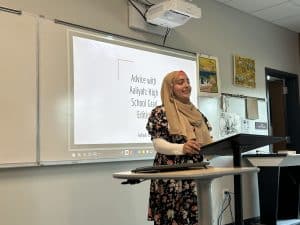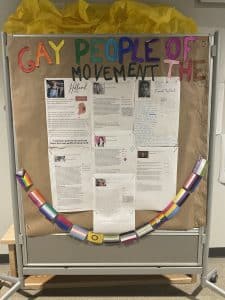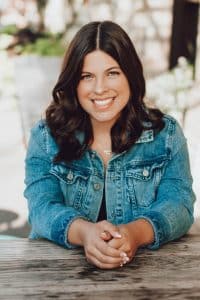Learning in a Supportive Community at Clark Street Community School
CompetencyWorks Blog
Recently, I visited Clark Street Community School located in Middleton, WI, a neighboring city of the capital of Wisconsin, and a quick drive (or bus ride, if you’re like me) to the University of Wisconsin (UW)-Madison. I chose the right time to visit; at the end of each semester, students at Clark Street Community School (CSCS) present their learning from various interdisciplinary seminars and personal projects in a Presentation of Learning (POL). I spent two days at CSCS and quickly gathered that their learning includes not just academic knowledge but also the skills and abilities they have gained or improved throughout the semester.
 CSCS has a student population of 100 and serves students from across the district. CSCS is connected to the district’s traditional high school, Middleton High School, which has a student population of 2,108 and embraces a traditional, test-prep-oriented learning environment. While located in the same building, these schools could not be more different, and the students I talked with confirmed that.
CSCS has a student population of 100 and serves students from across the district. CSCS is connected to the district’s traditional high school, Middleton High School, which has a student population of 2,108 and embraces a traditional, test-prep-oriented learning environment. While located in the same building, these schools could not be more different, and the students I talked with confirmed that.
Rather than single-subject courses with final exams, students at CSCS demonstrate their learning through the creation of Artifacts that make up their proficiency portfolio.
Artifacts are pieces of work that demonstrate students’ skills in five core proficiency areas: Reading, writing, mathematical modeling, communication, and research. They also are used to demonstrate an understanding of content-specific knowledge, which CSCS calls Elements.
The production of each Artifact requires students to go through a process of drafting; receiving feedback from peers, staff, and content experts; and making revisions in order to produce their final product. Whenever possible, Artifacts are shared publicly. POLs count as evidence for effective communication competency. To meet proficiency standards, students must go through this process and produce multiple pieces of work at a proficient level in each area.
This design allows each student to start at their current level of proficiency and grow from there while ensuring that all graduates leave with a skill level that will support success after high school. Combining Artifacts and Elements allows CSCS to focus on depth and feel confident that graduates have been exposed to key concepts within each content area. The systems in place at CSCS hold students accountable for rigorous, transparent work and allow for community building to naturally thrive at CSCS.
Preparing for the Presentations of Learning
When I visited during the last week of school, I witnessed the key role POLs play in the structure of the school community. The students spent multiple days engaged in 50-minute “Learn” and “Create” workshops focusing on learning crucial skills for their POLs or specifically on creating their POLs. Students signed up independently for these workshops the day before based on interest and personal needs related to their presentations.
To start the day, I sat in on a “Learn” workshop entitled Flashback: Assess Past POLs and Learn the Rubric. Every student in the room had a rubric and knew the expectations for their POL. Additionally, they were so comfortable with the expectations that they could assess past POLs and identify what was great and what could be improved according to the rubric’s objectives. This is an excellent example of rigorous, common expectations being accessible and transparent.
Next, I sat in on a workshop entitled Create the Manuscript, one of several “Create” workshops, in which students used their final speech draft and visuals to create a manuscript to help them with their presentation. Corinne Neil, the teacher in the room (yes, they call staff by their first names), led students through a quick mini-lesson regarding manuscript writing, using guiding questions to provoke thoughtful discussion among the students. Students actively participated when answering guiding questions and sharing their knowledge and personal experiences with other students about their past POLs. One student gave excellent advice to write “look up” or describe certain body motions in your manuscript, as the rubric requires effective eye contact, gestures, and body language to be proficient. One student suggested others create signals to “slow down” since you’re probably talking faster than you think you are, and another student said if you think you’re talking too slow, you’re probably talking at the best speed people can understand you at. Undoubtedly, students lost some independent work time because these conversations went longer than a typical 15-minute mini-lesson, but they gained something more valuable: shared knowledge to succeed in the expectations.
My next “Learn” workshop, Like, Ummm, So was a highlight. Students played games and activities focusing on public speaking skills, specifically not saying like, um, or so. Mary, the teacher in the room, offered me to join. I declined but realized I could’ve used the practice after seeing the students. When the first student was asked to speak about the American government for one minute straight, I was unsure what I expected. Still, I certainly wasn’t expecting him to speak so eloquently about the American government for one minute straight without using any filler words. I was impressed; I study political science, and I’m not sure I could do that. Students who weren’t initially engaged in the activity (I get it…I remember being in high school too) quickly became engaged, and everyone had a blast. Not only were kids having fun, but they were working on a skill crucial for their POLs later that week and a skill that would benefit them for a long time in their future academic and professional careers.

The Big Day
When I arrived at CSCS two days after my first visit, I was greeted by staff and students alike. Everyone was dressed for success; I could already tell it would be a great day. I chose to attend presentations located in the art room. The first POL I watched was given by a student named Ren, who described their experience planning out their schedule for that semester and how conflicts had caused them to be enrolled in classes they didn’t anticipate. Initially, Ren told the audience they had wanted to use first semester to take math and sciences seminars. However, there weren’t enough offered to fill their schedule. Ren described that, while initially disappointed, they quickly decided they had gotten tired of their own attitude and decided to make the best of things. Ren took a deeper dive into literature seminars to create a deeper understanding of concepts they had already mastered. Even though Ren had originally planned their schedule around specific graduation requirements, the practice and other skill sets from the new schedule were still valuable and good practice. This is crucial to competency-based learning, as academic knowledge should not be interpreted as things to check off and just complete and rather different experiences that create a well-rounded set of skills and knowledge.
A freshman, Henry, talked about new perspectives in their POL entitled: Thinking Outside the Box. Henry began their presentation with a graphic of a toilet. While initially silly and certainly an “outside the box” way to start the presentation, Henry dove into some excellent points. While in a seminar entitled Wordplay, Henry described their journey to acceptance of different perspectives and finding new ways to think about things. They used an example of water, diving into different ways water travels (the toilet is one of them), and what water means to him personally.
 Everest described their experience in a seminar this past semester about LGBTQ+ History. They talked about the meaningful, hands-on experience they got to have, like attending the Wisconsin Historical Society and writing a letter to a representative about an LGBTQ+ social justice issue they were passionate about. They also discussed how they were inspired by work done in the seminar and wanted to continue it through personal projects next year. This showed continuous learning and perseverance, and I was very impressed with Everest’s level of agency and advocacy. After all, high school students rarely discuss writing letters to policymakers. Most of my peers at UW-Madison (just down the road from CSCS) aren’t even able to display that level of advocacy.
Everest described their experience in a seminar this past semester about LGBTQ+ History. They talked about the meaningful, hands-on experience they got to have, like attending the Wisconsin Historical Society and writing a letter to a representative about an LGBTQ+ social justice issue they were passionate about. They also discussed how they were inspired by work done in the seminar and wanted to continue it through personal projects next year. This showed continuous learning and perseverance, and I was very impressed with Everest’s level of agency and advocacy. After all, high school students rarely discuss writing letters to policymakers. Most of my peers at UW-Madison (just down the road from CSCS) aren’t even able to display that level of advocacy.

One of my favorite parts of the day was when I visited the exhibition room, where students from a seminar on whether to reform the earth or colonize a new planet presented their chosen research through a rigorous, interdisciplinary project. Each focused on a different topic relating to personal passion and aligned with needed Elements and Artifacts towards their graduation progress. One student focused on space technology, while another did a deep dive on carbon sequestration to heal the earth we currently live on. I learned a lot from one student about polar jets, which was honestly a complex topic I did not understand before attending these POLs. Regardless of their topic choice, each student presented a high-level presentation on a topic and did it like an expert. It reminded me of UW undergraduate research symposiums that I have attended and presented at. During all these presentations, students received constructive feedback from their peers. It was amazing to see how productive and meaningful the feedback was, even when students weren’t looking at the rubric. It showed how clear and transparent the learning standards are and how students held themselves and each other accountable to those expectations.
Building Community
Clark Street Community School, like many CBE environments, is committed to equity and aligning its pedagogy and structures with equity principles. During POL week, I noticed students were reflective, gracious, and considerate when giving and receiving feedback, as well as working on their own skills. The Canopy Project recognizes CSCS for its commitment to restorative justice and practices within its school, which is crucial to repairing harm, bringing together students, and using dialogue to address issues within a community instead of using harmful, exclusionary disciplinary measures that promote inequities, like suspension or expulsion. I sat down with Jill Gurtner, the principal of CSCS, and we talked about restorative practices at CSCS, and she said the following:
“You have to build a community that you want to restore. If you are building a community students understand, ‘when I do something, it impacts other people.’ If you’re not building a community, there’s nothing to restore. Restorative practices would just become consequences to students, which has nothing to do with restoration.”
The sense of community at CSCS was prevalent throughout the entire visit; students gave hugs, talked in-depth, and worked with one another. Some students even cooked lunch together in their shared kitchen during lunch hour! When talking to students, I got an even greater sense of community when Amelie, a junior at CSCS, described how the students are super involved in developing the school community and school events. Even during POL week, the school got together and drew tickets for silly prizes you could get at the dollar store. Students and staff were excited to take a few minutes to come together as a community at the end of the day. Whether they’re decorating the hall with streamers to send off seniors, planning school events, co-teaching seminars, or giving each other constructive feedback, the sense of community is strong at CSCS.
The work being done at Clark Street Community School illustrates several essential elements of a CBE environment. Students are engaged, creative, and continuous learners. Students demonstrate mastery through high-level interdisciplinary projects, learning life skills for success, and participating in an environment grounded in equity and inclusion. CSCS has implemented systems within their CBE environment that ensures students are held accountable for rigorous, transparent work while fostering a natural environment for community building to thrive. I am excited about the work being done at Clark Street Community School and hope to visit again in the future.
 Briana Medina joined the Aurora Institute in May 2023 as a CompetencyWorks intern. She is a junior at the University of Wisconsin-Madison studying Political Science and Education Studies. She is committed to educational equity and is passionate about its relation to competency-based learning.
Briana Medina joined the Aurora Institute in May 2023 as a CompetencyWorks intern. She is a junior at the University of Wisconsin-Madison studying Political Science and Education Studies. She is committed to educational equity and is passionate about its relation to competency-based learning.
She currently serves on the UW-Madison College of Letters and Science Curriculum Committee, where she reviews and recommends course and program additions, revisions, and policies relating to academic offerings. In the past, Briana has worked as an intern at Kettle Moraine School for Arts and Performance, giving tours and teaching in a competency-based learning environment. Additionally, she worked with the Institute for Personalized Learning on panel discussions, high-level presentations, and blog posts.